Gayle Irwin's Blog, page 33
August 23, 2013
The Benefits of Play for Your Pet
 Playtime – something children and pets enjoy and adult humans should do more of. Activity and play are good for people and for our pets.
Playtime – something children and pets enjoy and adult humans should do more of. Activity and play are good for people and for our pets.Consider the wild cousins of our cats and dogs, those cougars, tigers, wolves and coyotes that wander the immense outdoors – searching, tracking, stalking, and chasing prey, and rolling, wrestling, and pouncing on their siblings and packmates. The wild ones engage in great amounts of activity; the furry companions living in our homes, more often than not, participate in the activity of... couch potato.
Most dogs were originally bred for some type of job such as herding, hunting, hauling, and guarding. These tasks required strong bodies and alert minds, and many breeds today still yearn for the work for which they were bred – you see that when your Corgi or Aussie Shepherd herds your kids! Cats also had jobs during the agricultural and early industrial age: keeping vermin, like mice and rats, at bay. Yet, today, most dogs and cats enjoy the lap of luxury – laying on the couch, floor, or pet bed. And sometimes that lack of activity leads to boredom and gets them into trouble.
There are many benefits for our pets to engage in play and other activities. In addition to being more physically healthy, exercise often alleviates unruly behaviors such as chewing, digging or scratching, hyperactivity, jumping on people, barking, whining, and meowing. These behaviors can not only be annoying but also destructive.
Mental stimulation is also important, particularly for those dogs bred for active jobs such as herding and hauling. Therefore, participating in more rigorous exercise like hiking and jogging or joining agility or tracking events not only exercises a dog physically but mentally as well. Playing with the cat using feather and laser toys engages kitty's prey and pounce instincts, again stimulating the cat's physical as well as mental abilities. Playing with your pet in the afternoon and evening helps tire it before bedtime, keeping it from being restless at night when you want to sleep – a great benefit for you!
So whether playing fetch with Fido, hiking with Holly, running the agility course with Ruger, or feather swirling and yarn twirling with Simba the cat, providing your pet with playtime reaps positive benefits for both you and your furry friend. And keep in mind that our pets want us to engage in activities with them – we are their special person, their pack, their clan. Think of how young wolves and lions wrestle with and stalk one another – they play together and hunt together. So spend time with your special canine or feline today engaging in some fun activities – your bond will grow even stronger … and the exercise will do you both good!
For more information on the benefits of playful activities with your dog, visit http://www.aspca.org/pet-care/virtual-pet-behaviorist/dog-behavior/exercise-dogs .
For further information on agility, tracking, and other dog events and activities, visit http://www.akc.org/dog_shows_trials/ .
For more information on enriching your cat's life with play and other activities, visit http://www.aspca.org/pet-care/virtual-pet-behaviorist/cat-behavior/enriching-your-cats-life .
Published on August 23, 2013 15:49
August 12, 2013
Benefits of Mature Pets
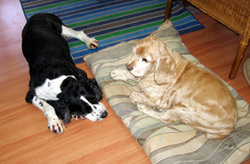 When I turned 50, AARP tracked me down, just like the organization does for thousands of people. There are many benefits to becoming a member, not the least of which is travel discounts. So, becoming “mature” does have its benefits!
When I turned 50, AARP tracked me down, just like the organization does for thousands of people. There are many benefits to becoming a member, not the least of which is travel discounts. So, becoming “mature” does have its benefits!Similarly, there are many benefits to adopting and living with a “mature” dog. My husband and I adopted our cocker spaniel, Cody, from our local humane society when he was 10 years old. This sweet and spry little guy was used as a stud dog then tossed away after “services rendered”. Five years later, Cody continues to enjoy his “retirement” years with us, sleeping on warm blankets, taking walks in town, and visiting our cabin in the mountains... oh, yes and eating yummy treats (especially glucosomine!).
Greg and I have enjoyed sharing these years with him. Cody is now 15, and for the past few years he's declined in health. Yet, we are grateful for the time and thankful we didn't pass him up because of his age. Many people would... and do.
Mary, too, is somewhat older. This loving springer/cocker mix we adopted in February is seven years old... yet, outside, she still has the bounce that springers are known for, but she is quiet and mellow inside the home. Mary, too, has made a fine companion for us... and for Cody.
Through the years in both my professional and personal lives, I’ve heard the “oohs” and “ahhs” regarding puppies and kittens, and the toutings of human parents who say “I want a puppy to grow up with my kids.” However, in animal adoption, age makes little to no difference when it comes to humans and pets bonding – most senior pets know the joy of spending time in a family and miss that companionship when they are yanked from their situation and turned into a shelter or rescue; these older gents and ladies are eager to find that sense of camaraderie and security once again. Cody's devotion to my husband and I has been strong since he first came to live with us. In fact, I’m sure if he could talk, he would constantly tell us ‘thank you!’ – his wagging tail certainly does!
There are many benefits to adopting a mature dog. Here are just a few:
Puppies require a great deal of attention and time, and for busy families, time is something of a commodity. Mature dogs can be left alone for longer periods and actually often enjoy ‘down time’. Now, this doesn’t mean they should be locked up in a kennel all day and it doesn’t mean they don’t need exercise – adult dogs just require LESS time and energy than puppies.
Young ones require training, such as housebreaking, and a great deal of patience. Older dogs often come housebroken and, in many cases, they have some basic obedience training, such as“sit”, “stay” and “come”.
What you see is what you get when you adopt an adult. Adopting a mature pet allows you to know its size and temperament, whereas adopting a puppy is sometimes a guessing game when it comes to the animal’s personality, height and weight.
Older pets expend less energy and require less activity. Often, a simple walk around the neighborhood for an older dog is sufficient, and you won't wear out your arm in endless hours of playing fetch! So if you’re not terribly active, perhaps a bit older yourself, a more mature dog might suit your lifestyle. Older cats, too, tend to be loungers, so you don't have as much worry about entertaining them as you do with a kitten or young adult cat.
Adopting an older pet is truly a selfless, often life-saving act. As an animal ages, its chances of adoption grow slimmer - by giving a mature pet a home, you’re showing great compassion and empathy (and gaining a wonderful furry friend in the process!)
Some people think if an older dog is in rescue or at the shelter there must be something wrong with it – not so! Many adult and senior pets are relinquished because the owner can no longer care for them due to the person’s health or even death. Some of the most wonderful companion animals in need of new homes are awaiting another chance to shower a family or individual with devotion, just as they did with their previous owner. Additionally, the number one reason people provide for giving up their pet is “I'm moving.” So, chances are the reason the pet is in need of a new home at it's older age has nothing to do with a behavior or other animal issue – it's simply the result of circumstances... and a human's decision.
So the next time you have opportunity to provide a dog or cat with a home, please consider adopting an adult or senior pet. Like my husband and I, you, too, will know the joy of hanging out with an adoring, mature four-footed friend and giving that animal a special, loving retirement home!
Published on August 12, 2013 10:07
July 29, 2013
Cool It, Dude! Summer Heat Safety for Dogs and Owners
 Too many times during the summer months, dogs get left in vehicles, their humans thinking if the windows are rolled down a bit and/or they park in the shade, the dog will be all right. Afterall, most dogs love car rides and spending time with their humans during travel; and, notably, we people enjoy having our furry friends for a ride-along. Yet, summer is a bad time to take your dog for a drive and then leave it in the vehicle while you run errands or have a doctor or hair appointment.
Too many times during the summer months, dogs get left in vehicles, their humans thinking if the windows are rolled down a bit and/or they park in the shade, the dog will be all right. Afterall, most dogs love car rides and spending time with their humans during travel; and, notably, we people enjoy having our furry friends for a ride-along. Yet, summer is a bad time to take your dog for a drive and then leave it in the vehicle while you run errands or have a doctor or hair appointment.Studies show the temperature inside a vehicle can rise 20 degrees in 10 minutes and nearly 30 degrees in 20 minutes. The inside of a vehicle, even with the windows cracked, can climb to nearly 150 degrees. Children and pets left inside vehicles, even with windows opened a crack, can suffer heat stroke and die, and unfortunately, that happens all too often.
Each year, an average of 38 children and numerous dogs die because of being left in cars during summer. As of the end of June this year, 15 children had died from heatstroke after being left in a vehicle, and many dogs have already succumbed to death in a hot car, including a Georgia K-9 dog left in the cruiser by his police handler last month.
A veterinarian, Dr. Ernie Ward, created a video in which he showcases the rising temperature and describes the ramifications of leaving a dog inside a vehicle, even with all four windows cracked about an inch. See the YouTube video at http://www.youtube.com/watch?v=6tJJ79YoFvM . Dogs and children do not tolerate heat as well as adults; in fact, dogs don't sweat in the same way as humans, so their ability to cool down from hot temperatures isn't as effective as ours.
So, keep your dog cool the remainder of this hot season and don't leave your beloved friend (or your children) in the car!
Other ways to help keep your dog cool include:
Clipping and grooming your pet – keep a short haircut on your furry friend to help keep him cool. Dogs and cats with longer, thicker hair stay cooler if they are clipped frequently during the summer. Older dogs, as well, may need trimming and shaving more often to lessen the burden of a heavier coat in summer.
Ensure there's plenty of fresh, cool water for your dog, whether in the house or staying outside in a kennel. And, if your dog is an outside dog, make sure there is plenty of shade for your canine companion – tress and bushes provide cool, refreshing shade in which to lay and get out of the summer sun.
Pets can sunburn just like humans, especially on the tips of the ears and on their nose, and those with white or light-colored fur, just like fair-skinned humans, are more susceptible to sunburn. Companies make sunblock just for pets – you may want to check those out or talk to your vet.
Walk your dog in the coolness of the morning or later in the evening after the sun goes down. Walking is good for dog and owner alike, but doing such exercise during the heat of the day can be unpleasant as well as dangerous.
Heat exhaustion and heat stroke can happen to our animals just like it can happen to people. So, cool it, dude, and keep your furry friend safe during these remaining “dog days of summer!”
Red Rover, an animal welfare nonprofit, offers tips and other information about keeping pets cool in summer. Visit their website for more information: http://www.redrover.org/mydogiscool .
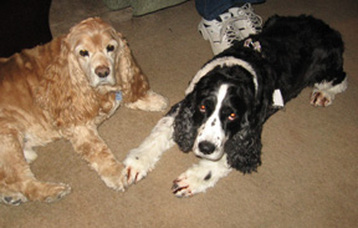 Cody and Mary enjoy their summer haircuts, keeping them cooler in the midst of the season's "dog days"!
Cody and Mary enjoy their summer haircuts, keeping them cooler in the midst of the season's "dog days"!
Published on July 29, 2013 08:01
July 20, 2013
Pets are Powerful Therapy!
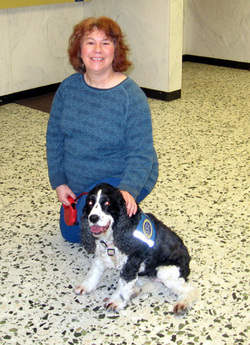 Research
shows pets provide great health benefits to people. They can reduce stress, lower blood pressure, uplift our moods, and add years to our life. The simple fact that our pets accept us for who we are, they love us unconditionally and are devoted companion, often waiting by the door for our return, makes us smile and builds our confidence and self-esteem. Dogs get us outdoors for fresh air and walks, and cats curl up in our laps and purr. All of these things and more are healthy benefits to people, both emotionally and physically.
Research
shows pets provide great health benefits to people. They can reduce stress, lower blood pressure, uplift our moods, and add years to our life. The simple fact that our pets accept us for who we are, they love us unconditionally and are devoted companion, often waiting by the door for our return, makes us smile and builds our confidence and self-esteem. Dogs get us outdoors for fresh air and walks, and cats curl up in our laps and purr. All of these things and more are healthy benefits to people, both emotionally and physically. People in nursing homes, hospitals, and hospice often feel weak, are in pain, and get discouraged. Many are lonely. Therapy pets raise their spirits, bringing smiles and joy into situations that can be sad and scary. Pet Partners , formally the Delta Society, and other groups certify pets and their owners for visiting these and other public places and studies show these animals provide great benefits to those whom they visit.
My Springer/Cocker mix Mary and I are certified as a pet therapy team by Therapy Dogs, Inc . We have visited schools and nursing homes and will continue these visits for some time to come. Mary makes an excellent pet therapy dog – she lies quietly on a floor or rug and lets children pet her in the classroom, or she goes to someone in a wheelchair and sits quietly as an elderly person pats her head. Mary enjoys interacting with people, young and old, and she seems to sense those who are in need of emotional connection. Dogs and people share a unique bond, and that becomes even more apparent in a setting such as a school or a nursing home.
Other animals, too, can be used in therapy situations; cats, bunnies, guinea pigs, even horses offer therapeutic value in various circumstances.
Unlike people with whom relationships can be complex, unpredictable, and stressful, animals are a great source of stability and companionship. Having a pet in one’s home can be calming and offer comfort when one is ill. Animals don’t change, and their loyalty to their owners and their ability to rebound from tough situations can be inspiring. The simple act of petting a dog or cat can lower blood pressure and bring a sense of calm to one’s spirit. Interacting with that pet in a playful manner can generate enjoyment and laughter. Even watching fish in a beautiful tank can bring about a sense of peace and an enjoyment of splendor through the colors of both the fish and the tank. And, don’t we all need a bit more tranquility and stability in our lives?
Pets are also a great source of comfort, especially for those affected by natural and other disasters. The K-9 Comfort Dogs from Lutheran Church Charities travel America to help quell the squall people experience after tornadoes, bombings, and other tragedies.
No matter what we’re experiencing, we find love, devotion, acceptance and comfort from the furry friends around us … and we can share that special beauty with others by being partners with our pets in helping those in our community and our country.
Have you hugged your pet today? Do so, and get a bit of pet therapy in your day!
Read an article I wrote about a Casper, Wyo., pet therapy group at the local hospice: http://www.casperjournal.com/news/article_dd2409fd-e3bf-5e2c-aba7-53f62cd522fa.html
Published on July 20, 2013 08:22
July 7, 2013
Dog Breeds Help Americans Celebrate Heritage
 In honor of America's Independence Day, let's look at some of the dog breeds that are “made in America.”
In honor of America's Independence Day, let's look at some of the dog breeds that are “made in America.”The Alaskan Malamute is the largest and oldest Arctic sled dog breeds. Although not designed to race, this dog's great strength and endurance makes it a formidable hauler of goods over long distances. It's named for a native Innuit tribe in Alaska.
Known for its bright, white coat and deep black lips and nose, the American Eskimo is an active, intelligent, and loving dog that was once used in circuses as a trick performer. “Eskies” do well in conformation and agility competitions. Despite it's name, the breed has nothing to do with Eskimos – it's lineage is European Spitz dogs.
Another breed with a name that fools is the Australian Shepherd. They were likely developed by Basque shepherds who came to America from Australia during the 1800s. These quick-witted, quick-footed dogs are versatile and intelligent workers, serving as pet therapy dogs, ranch dogs, and search and rescue dogs as well as family companions. They perform well in obedience and agility competitions.
The American Foxhound is one of the rarest American dog breeds as well as one of the oldest. George Washington, first president of the United States, is known as the father of the American Foxhound. This breed is bred to run and hunt, and therefore, is quite energetic.
The American Staffordshire Terrier, also called the Am Staff, is bred for intelligence and endurance; it's a great competitor in agility, tracking and obedience trials. The Am Staff is related to the Staffordshire Bull Terrier of England and is loyal and protective of its human family.
Another American breed with ties to England is the American Cocker Spaniel. These dogs are smaller in stature and with a different head shape than their English cousins. Though originally used as sporting dogs, most cockers today are companion animals.
The sturdy, muscular American Bulldog also differs from its English counterpart, having longer legs. This breed almost became extinct by the close of World War II. Loyal, determined and courageous, these dogs were used for bull baiting centuries ago, and though not naturally hostile, some municipalities consider it a bully breed.
Also a rare American breed, the American Water Spaniel is noted for its unique curly coat and excellent retrieving ability. It was developed in the Great Lakes region of the U.S. It's heritage is the Irish Water Spaniel and the Curly-coated Retriever. This breed is known as a wonderful sporting dog and family pet. It is the state dog of Wisconsin.
The Boykin Spaniel is another American spaniel that serves as an official state dog (South Carolina). This breed developed from a small stray dog that became an incredible retriever. Known for its love for people and its stamina, the Boykin is an excellent waterfowl and game bird retriever.
Such dogs seem to be liked by many states. The Chesapeake Bay Retriever is the state dog of Maryland. This breed originated during the 1800s from the mating of Newfoundlands with retrieving dog breeds. The “Chessie” is an intelligent, active dog that excels as a waterfowl retriever.
Originating from crossing an English bulldog with a white English terrier, the Boston Terrier is a smaller dog breed, developed after the Civil War as a fighting dog. Now known as the “American gentleman”, this little black and white dog is mostly a house pet, and is considered intelligent, loving, and loyal.
The Redbone Coonhound is a vocal breed that traces its heritage to Scottish and Irish red foxhounds brought to America about 300 years ago. Known for speed and agility, these dogs are also excellent swimmers. Their purpose is treeing game. This breed is fairly new to the American Kennel Club (AKC) competition, being recognized in 2010.
Another hound new to the AKC competition is the Treeing Walker Coonhound, recognized in 2012. This energetic, friendly dog's purpose is to track and tree raccoons. It is known for its great endurance and willingness to please.
There are several other American dog breeds. Learn about them and other breeds recognized by the AKC at www.akc.org .
Published on July 07, 2013 14:27
June 26, 2013
Water Safety for Your Dog
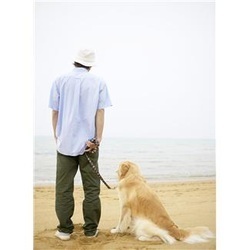 Summer’s heat can make a running river appear refreshing for people and pets, however, racing waters pose dangers for both. Therefore, pet owners, BEWARE!
Summer’s heat can make a running river appear refreshing for people and pets, however, racing waters pose dangers for both. Therefore, pet owners, BEWARE!Contrary to what many people think, not all dogs swim or swim well. Dogs can and do drown. Even the best of swimmers, like Labrador retrievers, can lose their life in the water, especially a swollen, fast-moving river or stream.
Like many people, most dogs enjoy a great swim – it’s good exercise and helps alleviate some of the summer heat. However, swimming is also dangerous, especially when the water is high. So, when you’re camping, hiking or fishing this summer, keep your dog close at hand and restrained so that you control how close s/he gets to that fast-moving water.
Lakes and ponds have their own dangers, including blue-green algae, chemicals and motor oil. Take special note if you see blue-green algae or chemical pollutants in the body of water and hose off your dog or bathe it when you get home. Boating with your dog can also cause concern. Just as people should have personal floatation devices (PFDs) [and remember, children are required to wear them while in the boat!] PFDs for dogs are also available.
According to outdoor gear specialists REI, the U.S. Coast Guard does not certify canine PFDs, however, these doggie life jackets can be life savers. The device should fit snugly so your dog cannot twist, step or swim out of it, and it should have easy-release buckles and a handle so you can lift your four-legged friend out of the water if necessary.
Pools are another area of concern. If you have a pool and own a pet, again, be cautious. Make sure your dog doesn’t swallow chlorine and make sure your dog knows how to get out of the pool – be sure there are steps into and out of the pool and that your dog knows where those steps are located. Cover your pool when no one is around to keep your dog (and your children) safe.
For more information and tips on dogs and water safety, visit
http://www.everydayhealth.com/pet-health/dog-and-water-safety.aspx or talk with your veterinarian.
Be safe this summer in and out of the water!
Published on June 26, 2013 12:22
June 5, 2013
Summer Safety Tips for Pets and Pet Owners
 With the dawning of June, summer is nearly upon us (and for some, the hot season has already arrived!). Keep your pets safe this summer by following these tips:
With the dawning of June, summer is nearly upon us (and for some, the hot season has already arrived!). Keep your pets safe this summer by following these tips: · Don’t leave pets unattended in your vehicle. Cars quickly heat up to dangerous temperatures, especially on warm or sunny days, even with the windows slightly open.
· Ensure your pets’ vaccinations are up-to-date and that heartworm, flea and tick medications have been administered. Summer brings out rabies-carrying creatures, such as skunks and raccoons, and fleas and ticks are abundant this time of year as well. Protect your pets! Consult your veterinarian for more information on heartworm, Lyme disease, rabies and other life-threatening diseases.
· When planning your dog’s daily walk, seriously consider early morning or later in the evening when it’s cooler. If you have to walk mid-day, take a shorter route, and remember that sidewalks can burn the pads of a dog’s paws.
· If your dog spends time outdoors in a kennel, ensure he has plenty of fresh, cool water and shelter. Rain and thunderstorms can pop up quickly, particularly in the afternoon when you may be elsewhere, such as work. And, NEVER chain or tie your dog out – lightening striking a nearby tree, heat exhaustion, dehydration and numerous insect bites are just a few of hazards posed to tethered dogs.
· For your cat’s protection, keep her indoors. Cats can be purr-fectly content indoor pets – they just need is a bit of playtime, a cat tree and other enrichment. Keeping your kitty indoors protects her from death by car, rabies from roaming creatures, and other safety issues, such as other cats and roaming dogs.
· Pesticides, weedkiller and other chemicals pose dangerous risks to pets and may even result in death. Ensure your pet cannot get into any of these hazardous products, and highly consider using organic products for your garden and yard.
· If your pet travels with you, make sure his/her ID tags are on the collar – you might even consider microchipping your pet before traveling. Also, use a leash to walk your pet for its bathroom break. One of the worst ways to ruin your vacation is to lose your pet.
· Prior to traveling, look into accommodations that accept pets. Here are a few websites that can help you plan your pet-friendly vacation: http://www.petswelcome.com/ and http://www.petsonthego.com/.
· If you don’t take your pet on vacation with you, look into hiring a reliable pet sitter. Ask friends or your vet for recommendations.
· Don’t leave your pets home alone if you’re gone for an extended period of time. Even asking friends to “drop by” to feed and water isn’t enough. Things can happen if a pet is left alone for days – running out of water, yard and house destruction, incessant barking which can result in upset neighbors – and possibly a fine to you by animal control.
· Don’t let the dog bite! Summer is the peak season for dog bites because of the increased number of children and dogs playing outdoors. Training, socialization and spaying/ neutering your dog help reduce the risk of dog bites. Also, remember to teach your children good manners around pets. To learn more about dog bites and how to prevent them, visit http://www.humanesociety.org/animals/dogs/tips/avoid_dog_bites.html.
Following these suggestions will help you, your family, and your pets have a safer, more enjoyable summer.
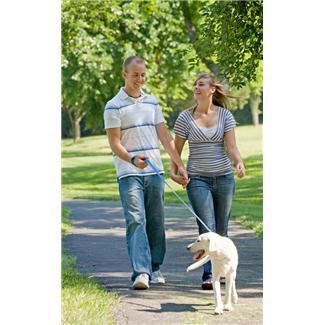
Published on June 05, 2013 13:14
May 27, 2013
Pets Can Have Allergies, Too
 With spring upon us and summer around the corner, many of us know the problems associated with allergies. A few of us even know the heartbreak of discovering someone in the family is allergic to the household pet. A large number of people give up the beloved dog or cat, while others take steps to delineate the allergens – from thorough cleanings and keeping the pet from the bedroom to taking allergy shots. Animal dander is not the only allergy from which people suffer – pollen, dust, and other allergens impact our bodies. Did you know our dogs and cats can also be affected by allergens? And, it’s not always a food allergy.
With spring upon us and summer around the corner, many of us know the problems associated with allergies. A few of us even know the heartbreak of discovering someone in the family is allergic to the household pet. A large number of people give up the beloved dog or cat, while others take steps to delineate the allergens – from thorough cleanings and keeping the pet from the bedroom to taking allergy shots. Animal dander is not the only allergy from which people suffer – pollen, dust, and other allergens impact our bodies. Did you know our dogs and cats can also be affected by allergens? And, it’s not always a food allergy.Many pet owners are concerned about corn in pet food products; some even stay away from all grain products. “Grain-free” pet foods are popular around the country, but it may not be rice, wheat, or corn to which your pet is allergic. Environmental allergens, such as pollen, fungus, even bugs can cause your dog or cat problems.
When Greg and I adopted Mary a few months ago, we were told she most likely had an allergy. Her foster mom, to be proactive, fed her a grain-free, salmon dog food. Mary didn’t seem fond of the food so when we brought her home, we put her on a grain-free venison product. However, her allergy situation didn’t abate, so our vet recommended we test Mary to be sure as to what she’s allergic to, so that we weren’t guessing as to the type of food to feed her.
We received the results of her allergy test in April. To our delight, Mary has only four food allergies (one being salmon – the others are corn, white potatoes, and flax). To our dismay, her primary problems are environmental. Among MANY other things, Mary is allergic to five types of grasses, a plethora of weeds (such as ragweed and lambs quarter), several trees (including elm and maple), mosquitoes, feathers, and cotton (is there a towel or blanket NOT made of cotton?!) So, Mary, like many people, undergoes allergy shots. We recently started her second series.
I am so glad we listened to our vet and pursued the discovery to what she’s allergic – we also received a results booklet explaining her allergies in greater depth. I never would have guessed my dog would be allergic to our elm tree in the back yard and the cotton towels used for bathing. Knowing we can treat her allergy problems for, in essence, less than $20 per month is a relief ($195 for the first year and $160 thereafter). Greg and I are committed to helping Mary endure these goofy allergies. Though we won’t cut down our elm tree, I found some non-cotton towels (which I even take to the groomer)!
Just like people can experience and then solve their allergy problems, so, too, can we discover and solve our pet’s discomfort. Some experts estimate more than 30 percent of pets’ skin irritations can be attributed to allergies.
As pet owners, we are responsible for the health of our dogs and cats. If your pet’s feet are discolored, they scratch their ears a lot, or have bald spots on the skin, talk with your vet and consider having an allergy test run. The initial outlay can be a bit overwhelming, but when you break down as I did a per month cost, it’s in essence a Starbucks a week; I can give up gourmet coffee to keep my pet healthy and happy – I’ll enjoy an extra cup at home with my beloved animals instead!
Published on May 27, 2013 16:43
May 15, 2013
Children's Book Week!
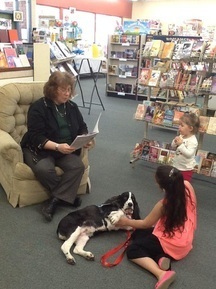 It’s Children's Book Week, a time to celebrate children's books and children’s authors. Three of my four current published works are written for children (but adults seem to enjoy them as well!) -- I've been fortunate to visit a few classrooms recently in preparation and celebration of this special literary recognition.
It’s Children's Book Week, a time to celebrate children's books and children’s authors. Three of my four current published works are written for children (but adults seem to enjoy them as well!) -- I've been fortunate to visit a few classrooms recently in preparation and celebration of this special literary recognition.As both a writer and a reader I've been influenced by many authors, most notably Laura Ingalls Wilder . She was my inspiration during my youth – I read all her “Little House” books, and I've read her works several times during my adult years as well. Since I grew up in southeastern Iowa, I related to Mrs. Wilder’s farm life, particularly in Missouri where she spent her later years. That home is located near Mansfield, MO – my maiden name is Mansfield -- combining those factors, I was thrilled when, while I was in high school, my parents took me to visit Laura's farmstead as we traveled through Missouri one summer. I visited again in 2007 when my husband and I traveled through the area on our way back to Wyoming from visiting his parents in North Carolina. Our blind dog, Sage, was with us then; the weather that December in southern Missouri was stunning, and as we walked the grounds of Rocky Ridge Farm, I reflected the impact Mrs. Wilder has had on children, youth, and adults since her first book was published in 1931 when she was 65 years old. My first book had been published earlier in 2007, and I had started visiting schools and sharing both my blind dog and the book I’d written about her. My career as an author began the year I was able to again visit my author heroine's property.
As you read my stories of long ago I hope you will remember that things truly worthwhile and that will give you happiness are the same now as they were then. It is not the things you have that make you happy. It is love and kindness and helping each other and just plain being good. - Laura Ingalls Wilder
There are many great childeren's books about a wide variety of topics and in a multitude of genres, some splashed with important life lessons. I write about dogs and weave positive lessons in my stories. I also discover valuable nuggets in others' works. Some of my favorite dogs books for kids (besides my own) are A Dog's Life: The Autobiography of a Stray by Ann Martin; Because of Winn Dixie by Kate DiCamillo; and The Tale of Two Bobbies by Kirby Larson. Ms. Larsen also writes historical fiction for kids – her Hattie Big Sky series is delightful! I've had the pleasure of meeting and talking with Ms. Larson, and, like Mrs. Wilder, I look up to Kirby for her accomplishments and her craft.
Though I'm not on the same level as the two women authors I most admire, I recently shared some of my stories at an event for families. We used the timing as a way to honor Moms, Kids and Dogs (for Mother's Day, Children's Book Week, and Be Kind to Animals Week). The event exposed youngsters and their families to a local author (me), someone who composes stories for them. I love sharing my writing with families in such settings, and I think it's great when authors go to libraries and schools – how I would have enjoyed meeting a real author, like Mrs. Wilder or Ms. Larson, when I was a kid!
So, this week, during Children's Book Week, expose your kids (or grandkids, nieces or nephews) to some great books – perhaps even take them to an author event. Sharing the gift of reading with children today positively impacts their future.
Happy Children's Book Week!
Children are made readers on the laps of their parents. - Emilie Buchwald, author
 Laura Ingalls Wilder - her first book was published when she was 65 years old, and her "Little House" series of books have touched lives for more than 80 years!
Laura Ingalls Wilder - her first book was published when she was 65 years old, and her "Little House" series of books have touched lives for more than 80 years!
Published on May 15, 2013 14:59
May 8, 2013
Teaching Kids Kindness to Animals and Other People
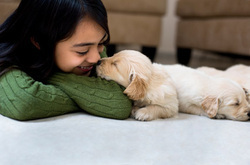 It's Be Kind to Animals Week, a time set aside by the American Humane Association and other organizations to promote kindness to animals. This is a great time to reinforce to children the importance of kindness, not only to animals, but also to other people.
It's Be Kind to Animals Week, a time set aside by the American Humane Association and other organizations to promote kindness to animals. This is a great time to reinforce to children the importance of kindness, not only to animals, but also to other people.In this day and age of bullying, child neglect, anger, violence and other issues, re-inforcing the concept of kindness is critical. Children are vulnerable, children are teachable – they often emulate what they witness in adults within the sphere of influence.
Therefore, we adults need to take stock not only in how we treat our kids, but also how we treat other adults and how we interact with pets in our own household, as well as within our community.
The ASPCA (American Society for the Prevention of Cruelty to Animals) offers some tips for celebrating Be Kind to Animals Week with children. For example, you and your kids can volunteer together at a local shelter or rescue. Although you may not be able to walk dogs, you can hold a bake sale or a collection drive, taking in donations of money and items necessary to run the shelter. Inquire at your local humane society or animal shelter (1) what their volunteer guidelines are and/or (2) what items they currently need. Another idea: spend time together as a family with your own pet – take a walk, play in the park, or toss a ball in your backyard for awhile. Pets need social interaction with their human families; remember to take good care of your pets and involve your children in that care. Your children may want to start a Kind Club with their friends and develop projects to help the homeless animals of your community.
Every year, nearly 7 million animals enter shelters across this nation. What can you and your family do to help these homeless creatures and the people who care for them? You and your children can positively impact your community, and therefore, the nation, by showing kindness to animals, and to other people.
Find some other tips for teaching and sharing kindness at http://behumane.org/component/content/article/2-uncategorised/82-be-kind-to-animals
“Teach your children well,” are part of the lyrics of a Crosby, Stills and Nash song. Those are words we can all live by, so let's teach our children, and ourselves, to be kind to others, both animals and people – when we do, we can all live in a better world.
Published on May 08, 2013 07:21



